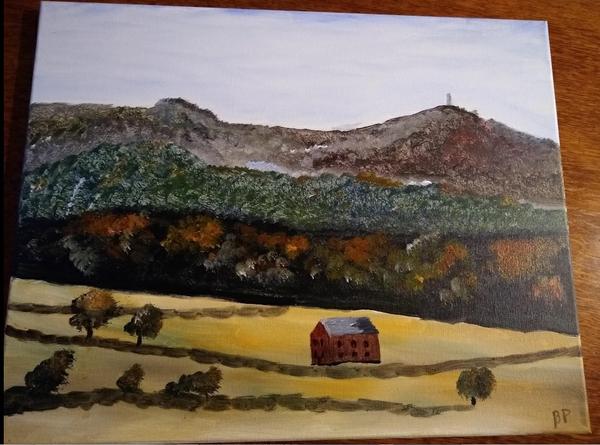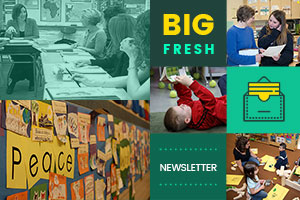Nine of us got together for our family girls’ weekend last fall. “Paint and Sip” is an activity all of us enjoyed, even though we range in age from teens to my 81-year-old mom. If you’ve never been to a Paint and Sip, it’s a two- or three-hour art class led by an artist. They are a lot of fun with the right group, no matter how much artistic talent you have. The artist guides you all through creating the individual portraits of the same image or scene.
Everyone in our group painted an autumn scene of Mount Greylock, the mountain just a few miles from the house we were renting. We had a fabulous time.

That’s my painting up above. It’s pretty good, right?
Actually, I know it’s not very good. How do I know this? Because before the group photo at the end of the session where we all stand together and hold up our pictures, both of my sisters insisted loudly that they wanted to stand next to me “because it would make their paintings look better.”
If you think this hurt my feelings, you’d be wrong. It just cracked us all up. If there is any gift greater than having two sisters as your closest friends to laugh (and cry) with for decades, I can’t imagine what it might be. And I give as good as I get.
But chuckling over that moment got me thinking afterward about standards. The problem with everyone always completing the same tasks isn’t only that it kills creativity and independent thinking. Students aren’t just looking up at the standard — they are looking sideways at their peers, continuously judging who is good/better/best. It may be the biggest challenge of teaching to help students see what is uniquely their own in terms of skills, interests, and ways of learning. Nothing wrong with looking up. It’s the sideways glance that can kill students’ ability to see themselves as readers, writers, or artists.
One fall many years ago I was admiring a display of pumpkins decorated by second graders. The task was to bring things from home you could recycle or use in some way to decorate your individual pumpkin. The children with moms and dads who were crafters brought in sequins and bits of fabric. Other children used newspaper in creative ways. But my favorite pumpkin was decorated by a child whose family dog had been sprayed that week by a skunk. His dad had shaved most of the hair from the dog to lessen the odor. The boy brought a big bag of dog hair for decorating and glued it all over the pumpkin, adding a couple of googly eyes and declaring it was a werewolf pumpkin.
Each pumpkin had a citation next to it—a unique award. That boy received the award for “The World’s Hairiest Pumpkin.” I went through and read the other awards, and no two were alike. I thought of the energy the teacher must have put into coming up with something positive and different to say about each pumpkin, and the fun she must have had in writing those citations.
So let the high-standards folks say pish posh to finding good and honoring attempts outside the norm. Let them accuse us of encouraging mediocrity. Thirty years later, what I still remember is the world’s hairiest pumpkin and the teacher who had the good humor and grace to celebrate it. When you quit rank ordering and put away the rubric, it’s surprising what emerges that endures.
This week we look at ways teachers work with student struggles to find strengths. Plus more as always—enjoy!
Brenda Power
Founder, Choice Literacy

After six months of work behind the scenes, the redesigned website is live. We hope you’ll take a tour of new and familiar features.
Wouldn’t you love to put yourself in a time machine and go back to your earliest days of learning to read? Shari Frost is able to experience learning to read again when she takes on the Hebrew alphabet and language. She gleans many insights for her work with struggling young readers.
Clare Landrigan and Tammy Mulligan offer three simple strategies to use during writing conferences with struggling students.
In these divisive times, it’s a struggle for many teachers to talk about race and gender with students. Mary Lee Hahn shares her process of integrating more of these conversations into her classroom, as well as many wonderful books to use as catalysts for discussion.
Check out our new online course program. Instructors include Ruth Ayres, Katherine Sokolowski, Jennifer Schwanke and many others. Members receive discounts of 20-40% on course fees, and nonmembers receive three-month trial memberships to the website.

New members-only content is added each week to the Choice Literacy website. If you’re not yet a member, click here to explore membership options.
Christy Rush-Levine decides to slow down in her classroom and engage more fully with a student who is a wiseacre and resistant reader. What happens next can only be described as magic.
Do struggles with handwriting matter? They do when a student can’t even decipher his own words. In this week’s video, Katherine Sokolowski confers with fifth grader Sauvi to help him find solutions to the problem.
Melanie Meehan explains why it is important to mentor students who are struggling with correct examples, and why she cautions writing teachers to avoid “find the mistakes” exercises.
In an encore video, Max Brand takes two kindergarten English language learners from reading a familiar book to exploring a new text, and explains in the debrief how he targets specific reading skills.
Our featured contributor this week is Shari Frost. Shari has taught in elementary grades through the university level, and enjoys nothing more than rolling up her sleeves and helping teachers and students with anything that is a challenge. She is the author of the book Rethinking Intervention: Supporting Struggling Readers and Writers in Grades 3-6 Classrooms. You can find her latest writing for Choice Literacy at this link.

Lead Literacy now has a new home as the Leaders Lounge at Choice Literacy. We’ll be posting the new content updates here in the Leaders Lounge section of the Big Fresh newsletter.
Cathy Mere begins her second year of working with Nathan, a struggling young reader. She shares her “rules” for collaborating with teachers over students who are hard to teach.
Clare Landrigan leads a demonstration lesson with a pair of kindergarten students who struggle with letter-sound connections. In the video, she explains why these “quick and frequent” reading activities are helpful for young learners who find it a challenge to participate in guided reading groups.
Elena Aguilar grapples with one of the toughest situations literacy leaders face—assisting a teacher who is in crisis. This article requires a free registration at EdWeek to access.
Have you claimed your 40% Literacy Leader subscription discount for one of our online courses yet? Instructors include Ruth Ayres, Dana Murphy, Katherine Sokolowski and many others. Details are at this link.
Quote It:
You will never be entirely comfortable. This is the truth behind the champion—she is always fighting something. To do otherwise is to settle.
Julien Smith
That’s all for this week!



